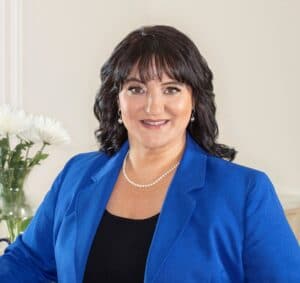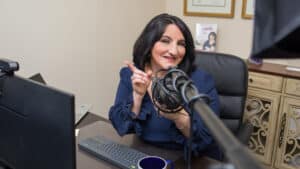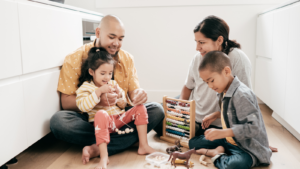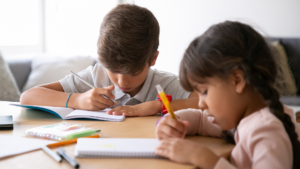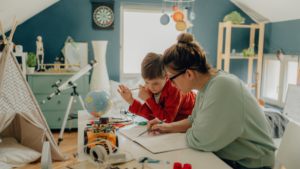What Is Brain Mapping and How Does It Work?
A brain map is an objective measure of brainwave activity that gives us information about the function of the brain in specific regions of the brain (e.g. the frontal lobes which are the attention center of the brain) and how the brain processes information from site to site or how it communicates. Think of brain communication as how many highways a brain has; the more highways, the easier it is for one to pay attention, learn, and regulate.
QEEG data allows us to see unique patterns of your brain and understand what areas have too much or too little brainwave activity, as well as normal, poor, or hypercommunication between sites. This visual representation of the brain waves allows us to see what areas of the brain are working too hard or not enough.
When we know what regions are under or overworking, we don’t have to guess about what is happening with behavior because we know exactly what each region can do. For example, if your child had too much activity in the limbic system, then we would see emotional and behavioral regulation issues. Having this kind of knowledge is the key to helping your child pay attention, be calm, and be successful in school.
A QEEG brain map or a brain check is a critical first step in the process of beginning neurofeedback, which is a therapy that can create lasting change. A QEEG brain mapping is a science-backed tool that can help with clinical conditions such as ADHD, executive functioning, anxiety, OCD, PANS/PANDAS, Lyme, learning and processing issues, and depression.
Where In The Brain Is Memory Stored?
Understanding where memory is stored in the brain is crucial in assessing and addressing cognitive functions. Memory is a complex process involving various brain regions.
The hippocampus, a seahorse-shaped structure in the medial temporal lobe, is particularly important for the formation of new memories. Additionally, the amygdala, thalamus, and cortex play significant roles in different aspects of memory, including emotional memory and long-term storage.
A QEEG brain map can provide insights into the functioning of these memory-related brain regions (Emad-Ul-Haq et al., 2019). Identifying any abnormalities or irregularities in these areas can contribute to a more comprehensive understanding of cognitive issues and guide targeted interventions.
How Is Brain Mapping Done?
A brain map involves putting a special cap on that has built-in sensors and then using conductivity gel so the sensors can measure your brain activity at 19 sites. Data is collected with eyes closed and eyes open for about 5 minutes each. It is an easy process for kids and adults and can be done in as little as 15 minutes.
The data is edited to remove artifacts, such as eye blinks and other body movements. Next, the person’s data is compared to a database of others in a similar age range. Reports vary depending on the QEEG software but generally give information about the function of each structure and about the communication between brain sites.
It is important to note that both the function over specific brain regions and brain communication are equally important functions in the brain and regulation of each can go a long way in improving mental health symptoms.
What Is Brain Mapping Used For?
Brain mapping is a versatile tool with applications across various clinical conditions. It serves as a critical first step in the process of beginning neurofeedback, a therapy that can create lasting change.
QEEG brain mapping is a science-backed tool that can help with clinical conditions such as ADHD, executive functioning, anxiety, OCD, PANS/PANDAS, Lyme, learning and processing issues, and depression (Fingelkurts & Fingelkurts, 2022).
This diagnostic tool provides valuable information to guide treatment decisions and ensures that interventions are tailored to address specific brainwave patterns and areas of concern.
Is Brain Mapping Dangerous?
Brain mapping, through QEEG, is a safe and non-invasive procedure. The use of FDA-approved hardware and software, along with careful data collection and analysis, ensures the process poses no danger to individuals undergoing brain mapping.
Is QEEG Legit?
The legitimacy of QEEG lies in its approval by the FDA, as it ensures the safety and effectiveness of the hardware and software used to measure brain wave activity. While there are different types of QEEG software, all are considered valid measures of surface brain wave activity.
Are There Different Types of QEEG Software?
There are different types of QEEG software and hardware used to measure brain wave activity. All QEEG hardware is approved by the FDA and the selection of both software and hardware is largely determined by the preference of the clinician despite what you are told, they are all effective measures of surface brain wave activity.
What is the Difference Between an EEG and a QEEG?
Many confuse a QEEG with an EEG but the two are different ways of looking at brain wave activity. EEG is the raw brain wave data and is most often used by neurologists to look for seizure and pre-seizure brain activity. A QEEG is an analysis of EEG at multiple sites and then is processed to give a visual representation of a person’s brain wave functioning. Most QEEGs look at 19 sites but there are also ones that look at 10 sites and as many as 200 sites.
What Does Brain Mapping Tell You?
QEEG Brain Mapping Interpretation involves a comprehensive analysis of collected data and a clinical intake. Dr. Roseann, with her wealth of experience, interprets each QEEG personally, guiding treatment decisions and customizing protocols for her clients. The interpretation is a blend of scientific knowledge and practical experience to ensure a thorough understanding of the data.
What is a QEEG Brain Mapping Interpretation Like?
A QEEG with Dr. Roseann involves looking at the data and a clinical intake. Collected data is statically analyzed and condensed into a digestible and useful report. As part of clinical intake, a brain map helps guide treatment, as well as measure treatment. Here is an example of a QEEG brain mapping ADHD.
How Do You Interpret QEEG Brain Mapping Results?
Interpreting QEEG brain mapping results is a meticulous process that requires a combination of scientific knowledge and clinical expertise. The collected data undergoes statistical analysis, and the findings are condensed into a digestible and useful report. This interpretation is an integral part of the clinical intake, guiding not only the initial treatment decisions but also serving as a tool to measure progress over time.
Understanding the nuances of brainwave activity and recognizing patterns indicative of specific conditions allows for targeted interventions. In the case of ADHD, for example, a QEEG brain mapping ADHD might reveal areas of excessive activity in certain brain regions, guiding the development of a neurofeedback protocol tailored to address these specific challenges.
Does Dr. Roseann Do Her Own Brain Map QEEG Analysis?
Dr. Roseann interprets every QEEG and designs custom protocols for all her clients. Not every neurofeedback provider can interpret a QEEG test and make a neurofeedback protocol. Most send the collected data to an outside consultant, so they aren’t able to fully understand the data or make real-time changes. QEEG interpretation is a combination of scientific knowledge and a whole lot of experience and Dr. Roseann has interpreted thousands of QEEG brain maps.
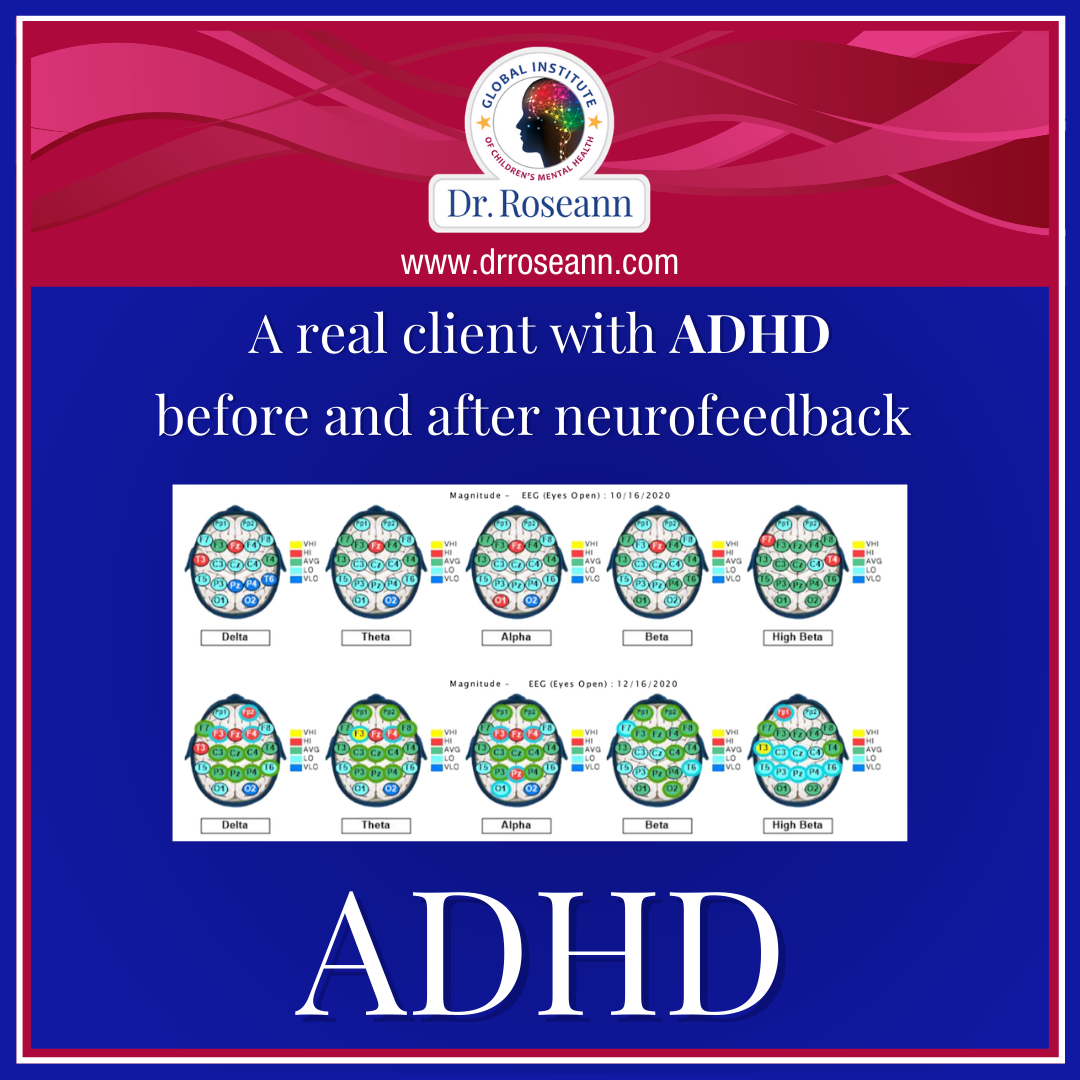
Why Is Brain Mapping Important?
Brain mapping holds paramount importance in the field of mental health diagnostics and treatment planning. Traditional methods of diagnosis often rely on subjective observations and interviews. It leads to a lack of precision in understanding the underlying neurological factors contributing to mental health issues.
A QEEG brain map provides an objective, data-driven approach to reveal intricate details about brainwave patterns, communication between regions, and areas of over or under-activity. This critical information allows for a more accurate diagnosis and enables clinicians to tailor treatment plans with precision.
The significance of brain mapping extends beyond diagnosis. It plays a pivotal role in tracking treatment progress. The periodical assessment of changes in brainwave activity can help fine-tune interventions. It also ensures that therapeutic approaches are effective and adjustments can be made in real time.
In the context of Dr. Roseann's practice, brain mapping is integral to her trademarked BrainBehaviorReset™ Program. It is the key that unlocks a deeper understanding of an individual's cognitive functions and paves the way for targeted interventions that improve alertness, increase calm, and foster a positive mental health trajectory.
Who Can Use The QEEG Mapping Brain Imaging Technique?
The versatility and non-invasiveness of the QEEG mapping brain imaging technique make it suitable for a wide range of individuals across various age groups. This diagnostic tool is particularly valuable for:
1. Children and Adolescents
QEEG mapping is highly beneficial for children and adolescents experiencing behavioral, emotional, learning, attentional, or social challenges. It provides a comprehensive understanding of their brainwave patterns to aid in the identification of underlying issues contributing to their symptoms.
2. Adults
Adults facing mental health concerns such as anxiety, depression, ADHD, or executive functioning issues can benefit from QEEG mapping. The technique offers insights into specific brain regions that may be overactive, underactive, or experiencing communication issues, guiding the development of targeted interventions.
3. Individuals with Neurological Conditions
QEEG mapping applies to individuals with neurological conditions such as epilepsy or traumatic brain injuries. It can help assess the impact of these conditions on brainwave activity, assisting in treatment planning and monitoring.
4. Those Seeking Neurofeedback or Brain-Based Interventions
Individuals interested in neurofeedback or other brain-based interventions can use QEEG mapping as a foundational step. The information obtained from the brain map guides the development of personalized neurofeedback protocols to ensure that interventions are tailored to individual needs.
5. Anyone Seeking Objective Mental Health Assessment
QEEG mapping provides an objective and data-driven assessment of mental health, offering an alternative to traditional subjective methods. Individuals seeking clarity on their cognitive functions and mental well-being can benefit from the precision and insight provided by QEEG mapping.
How Can a Brain Map Help Mental Health?
One of the greatest weaknesses in mental health is that most clinicians are basing a diagnosis on clinical opinion without using objective data. A brain map is an objective tool that gives us clear information about what areas of the brain are working or not.
At our center with both our at-home neurofeedback and in-person neurofeedback clients, we use a QEEG to “check under the hood” and get the right information, so we can design the right wrap-around treatment protocol. Neurofeedback is part of Dr. Roseann’s trademarked BrainBehaviorReset™ program that focuses on improving alertness, increasing calm, and helping kids feel good about themselves.
How Can QEEG Brain Map Data Track Treatment Progress?
At our center, we use a QEEG brain map to track the progress of not only neurofeedback, biofeedback, and PEMF therapy, but we can also use it to track the progress of other treatments. For example, we have used a QEEG brain map pre and post-gluten removal and even to measure the effect of meditation. It is a wonderful objective data tool that measures brain changes. `
What Does The Research Say About a QEEG Diagnosis?
Research supports that QEEG brain mapping is more effective than behavioral ratings in identifying those with ADHD. QEEG is 89 % accurate as a diagnostic test versus behavioral rating scales which were 47% to 58% accurate (Snyder et al., 2008).
Having done thousands of clinical intakes, QEEG brain map data can give insight into the root causes of a child’s or teen’s behavioral, emotional, learning, attentional, or social issues in a way an interview can’t.
Does Brain Mapping Really Work?
People ask, “Does Brain mapping work?” and after someone has one, they know the answer is, “YES!” QEEG Brain mapping is a wonderful diagnostic tool that gives individuals and parents accurate information to get the right treatment.
Remember, if you don’t know what the right issue is, how can you get the right treatment? You can’t! That is why a brain map or a brain check is a critical step in treatment and Dr. Roseann feels so strongly about how essential they are in guiding treatment. You can’t work with her without one.
QEEG Brain Mapping Reviews
Reviews and case studies from individuals who have undergone QEEG brain mapping highlight the transformative impact of this diagnostic tool. The wealth of positive feedback underscores its importance in guiding individuals toward effective solutions for mental health challenges.
Parent Action Steps
☐ Learn about QEEG brain mapping to gain objective insights about mental health.
☐ Use QEEG to uncover neurological factors contributing to behavioral challenges.
☐ Familiarize yourself with the safe and non-invasive process of QEEG brain mapping.
☐ Acknowledge the versatility of QEEG when applied across ages.
☐ Consider QEEG mapping to assess the impact of neurological conditions.
☐ Recognize QEEG as a foundational step for personalized and effective treatment plans.
☐ Consider QEEG mapping as an objective alternative for assessing mental health.
☐ Read reviews showcasing the transformative impact of QEEG mapping.
☐ Get to the bottom of your child’s issues through the BrainBehaviorResetTM Program.
☐ Download The Ultimate Guide to Boosting Neurotransmitters Naturally
Citations
Emad-Ul-Haq, Q., Hussain, M., Aboalsamh, H., Bamatraf, S., Malik, A. S., & Amin, H. U. (2019, April 30). A Review on understanding Brain, and Memory Retention and Recall Processes using EEG and fMRI techniques. ArXiv.org. https://doi.org/10.48550/arXiv.1905.02136
Fingelkurts, A. A., & Fingelkurts, A. A. (2022). Quantitative Electroencephalogram (qEEG) as a Natural and Non-Invasive Window into Living Brain and Mind in the Functional Continuum of Healthy and Pathological Conditions. Applied Sciences, 12(19), 9560. https://doi.org/10.3390/app12199560
Snyder, S. M., Quintana, H., Sexson, S. B., Knott, P., Haque, A. F. M., & Reynolds, D. A. (2008). Blinded, multi-center validation of EEG and rating scales in identifying ADHD within a clinical sample. Psychiatry Research, 159(3), 346–358. https://doi.org/10.1016/j.psychres.2007.05.006
Are you looking for SOLUTIONS for your struggling child or teen?
Dr. Roseann and her team are all about solutions, so you are in the right place and starting with a QEEG brain map or a brain check is the first step.
There are 3 ways to work with Dr. Roseann:
- In-person at her Ridgefield, CT center
- Virtually with her home-based neurofeedback and coaching programs
- By getting her Get Unstuck Program
You can get her books for parents and professionals, including: It’s Gonna Be OK™: Proven Ways to Improve Your Child’s Mental Health, Teletherapy Toolkit™ and Brain Under Attack: A Resource For Parents and Caregivers of Children With PANS, PANDAS, and Autoimmune Encephalopathy.
Are you a professional who wants more training from Dr. Roseann?
Purchase her book, Teletherapy Toolkit™: Therapist Handbook for Treating Children and Teens.
If you are a business or organization that needs proactive guidance to support employee mental health or an organization looking for a brand representative, check out Dr. Roseann’s professional speaking page to see how we can work together.
Dr. Roseann is a Children’s Mental Health Expert and Licensed Therapist who has been featured in/on hundreds of media outlets including The Mel Robbins Show, CBS, NBC, PIX11 NYC, Today, FORBES, CNN, The New York Times, The Washington Post, Business Insider, Women’s Day, Healthline, CNET, Parade Magazine and PARENTS. FORBES called her, “A thought leader in children’s mental health.”
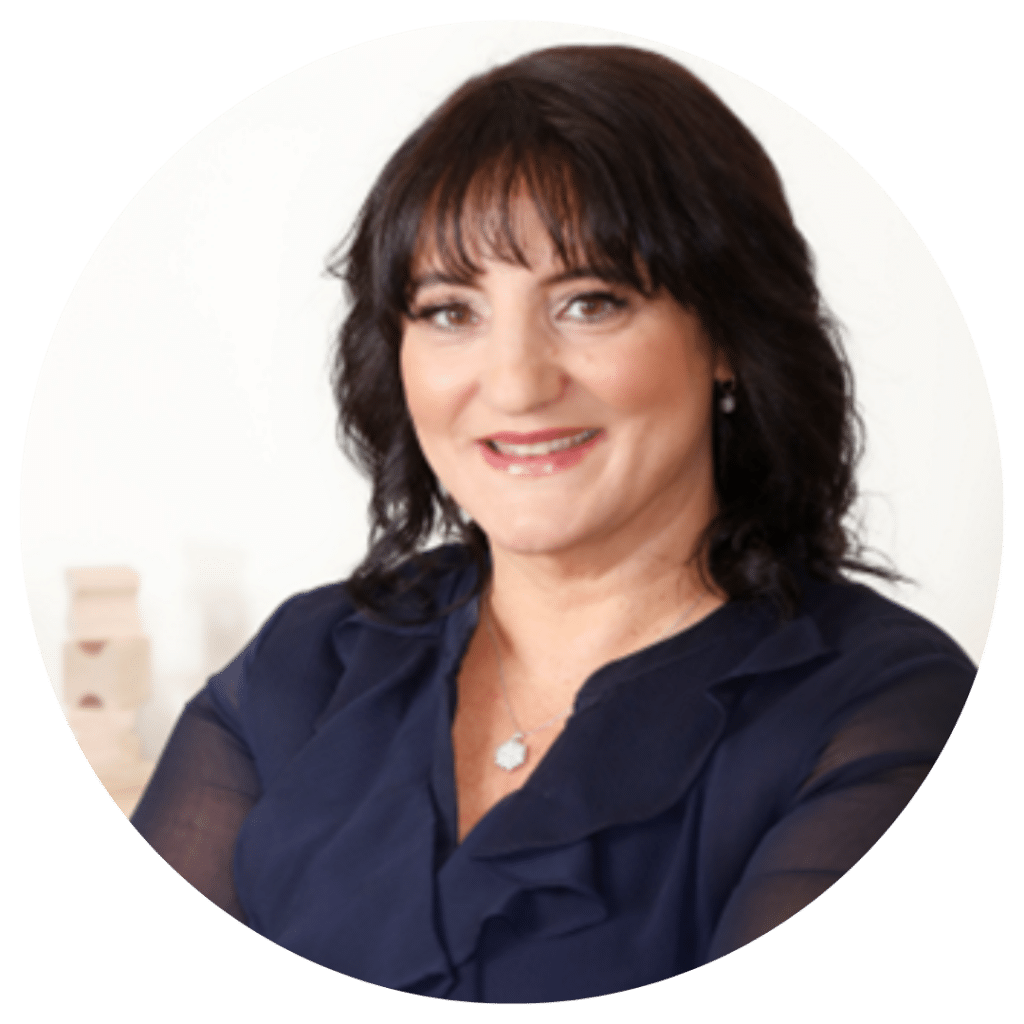
She coined the terms, “Re-entry panic syndrome” and “eco-anxiety” and is a frequent contributor to media on mental health.
Dr. Roseann Capanna-Hodge has three decades of experience in working with children, teens and their families with attention-deficit hyperactivity disorder (ADHD), autism, concussion, dyslexia and learning disability, anxiety, Obsessive Compulsive Disorder (OCD), depression and mood disorder, Lyme Disease, and PANS/PANDAS using science-backed natural mental health solutions such as supplements, magnesium, nutrition, QEEG Brain maps, neurofeedback, PEMF, psychotherapy and other non-medication approaches.
She is the author of three bestselling books, It’s Gonna Be OK!: Proven Ways to Improve Your Child's Mental Health, The Teletherapy Toolkit, and Brain Under Attack. Dr. Roseann is known for offering a message of hope through science-endorsed methods that promote a calm brain.
Her trademarked BrainBehaviorResetⓇ Program and It’s Gonna be OK!Ⓡ Podcast has been a cornerstone for thousands of parents facing mental health, behavioral or neurodevelopmental challenges.
She is the founder and director of The Global Institute of Children’s Mental Health, Neurotastic™Brain Formulas and Dr. Roseann Capanna-Hodge, LLC. Dr. Roseann is a Board Certified Neurofeedback (BCN) Practitioner, a Board Member of the Northeast Region Biofeedback Society (NRBS), Certified Integrative Mental Health Professional (CIMHP) and an Amen Clinic Certified Brain Health Coach. She is also a member of The International Lyme Disease and Associated Disease Society (ILADS), The American Psychological Association (APA), Anxiety and Depression Association of America (ADAA) National Association of School Psychologists (NASP), International OCD Foundation (IOCDF).
© Roseann-Capanna-Hodge, LLC 2023
Disclaimer: This article is not intended to give health advice and it is recommended to consult with a physician before beginning any new wellness regime. *The effectiveness of diagnosis and treatment vary by patient and condition. Dr. Roseann Capanna-Hodge, LLC does not guarantee certain results.


